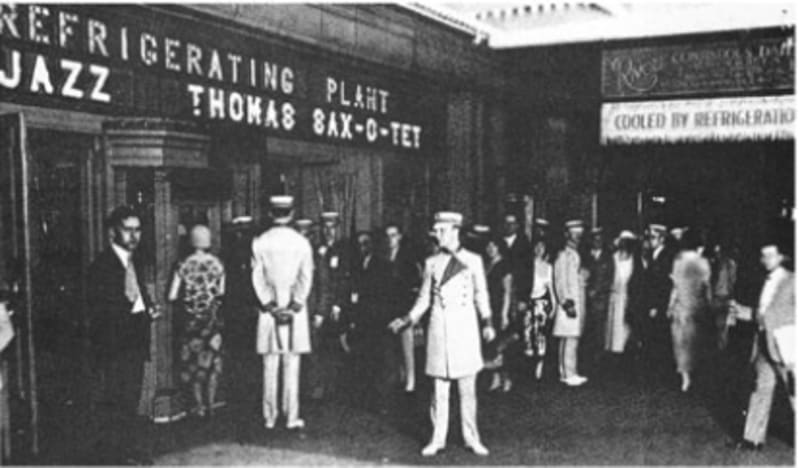Willis Carrier's epiphany in the fog

‘Air conditioning’ is a loose term, and can refer to air in buildings being treated in different ways. Modern systems generally do four things. They clean the incoming air. They warm or cool the air as appropriate. They alter the level of moisture in the air. (They humidify or dehumidify it.) And they continually renew the air and move it through the building to provide ventilation. Early systems built at the start of the 20th century in America, where air conditioning was invented, did not always do all of these things.

Most Americans first learned about air conditioning in the movie theatre, where the emphasis was on cooling. The earliest cinemas in the late 19th century were improvised from halls, vacant shops or warehouses. The tightly-packed, sweaty audiences created intolerably hot and close conditions, and most theatres shut over the summer months. From the 1920s, purpose-built ‘motion picture palaces’ were air conditioned with refrigeration plant. Temperatures in the summer were deliberately kept much lower than outside, and the public was attracted as much by the cooling as by the movies on the programme. Another type of building that was air conditioned at the same period, and for similar reasons, was the department store. It was easier, in those early days of the technology, to condition single large spaces than treat buildings with many rooms.
Refrigeration with blocks of ice had been used in meat processing in the Middle West in the 19th century. In 1893 Dr R Ogden Doremus, a science professor in New York, asked why the same could not be done for people: “If they can cool dead hogs in Chicago, why not live bulls and bears [i.e. traders] in the New York Stock Exchange?” The engineer Alfred Wolff did just that: he built a highly effective air conditioning system for the Exchange in 1901, which lasted twenty years before being replaced. The cooling was achieved with mechanical refrigeration. But Wolff was also very concerned with humidity, since people feel uncomfortable not just if it is too hot or too cold, but if it is too sticky or too dry. Humidity and temperature are related: when the air is warmer it can hold more water vapour. Wolff removed moisture from the incoming air at the Stock Exchange by condensing it onto pipes carrying chilled brine.
Wolff also built air conditioning plant that controlled both humidity and temperature for the mansions of millionaires including Cornelius Vanderbilt and Andrew Carnegie. But these were expensive tailor-made systems. Air conditioners for houses did not come within the financial reach of ordinary Americans until the 1930s.
Where the technology was first developed commercially on a large scale, it was not for the benefit of humans at all, nor did it necessarily involve cooling. The term ‘air conditioning’ was coined by Stuart Cramer, who worked on systems for controlling the atmosphere in textile mills in the Southern states in the 1910s and 1920s. Cramer was focussed on the problem of humidity. In New England, where many 19th century woollen mills were concentrated, the climate was naturally humid, but in the South the air needed to be made moister so that the cotton remained workable.
With other manufactured products the problem was the opposite: they are sensitive to excess humidity. Spaghetti and macaroni do not dry properly in the wrong atmospheric conditions. Excess moisture can cause chocolate to develop a grey powdery bloom. The paper used for printing can stretch or shrink under changes of humidity, so that one colour printed over another gets out of register. It was relatively easy to add moisture to air, but how could it be removed from air that was too damp? Wolff used the surfaces of cold pipes, but the method was not easily controllable.
This was the problem preoccupying the engineer Willis Carrier in the early 1900s. (Carrier is often called ‘The Father of Air Conditioning’, which is rather unfair to Wolff and Cramer, although it was Carrier who turned the technology into a large-scale manufacturing business.) Carrier was waiting for a train on Pittsburgh station one chilly evening in the autumn of 1902, and the platform was wrapped in fog. His biographer Margaret Ingels describes what happened next. “As Carrier paced back and forth… he began thinking about fog. As he thought he got the “flash of genius”, as patent experts put it, that eventually resulted in “dew-point control”, which became the fundamental basis of the entire air conditioning industry.”
Carrier imagined making an artificial fog with a fine spray of water. He would pass the incoming air supply through this spray. If the water was warmed, the result would be to moisten the air. But if the water was cooled, water vapour in the air would condense onto the mist droplets, and the result would be to dry the air. He would dehumidify air with water! The idea seemed paradoxical, and was greeted with ridicule in some quarters. Carrier’s ‘Eureka’ moment even earned him a place in Ripley’s ‘Believe It or Not’ in 1939. But after a series of experiments, Carrier got the opportunity to test the principle at the Eastern Tanners Glue Company in Gowanda, New York, and it worked. In 1906 he secured a patent on his ‘Apparatus for Treating Air’. Very soon spray-type equipment became general throughout the world of air conditioning, and Carrier began to grow the company which continues to operate internationally under his name today.
Margaret Ingels, Willis Haviland Carrier, Father of Air Conditioning, Country Life Press, Garden City, 1952
Gail Cooper, Air-Conditioning America: Engineers and the Controlled Environment, 1900-1960, Johns Hopkins University Press, Baltimore and London 1998